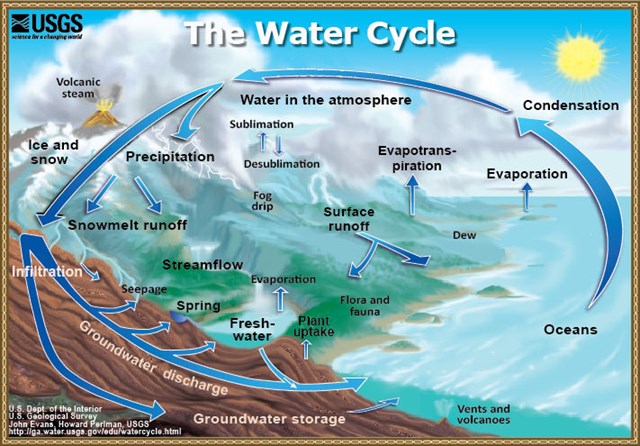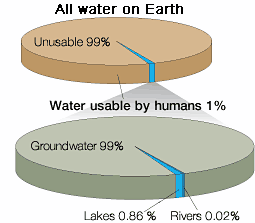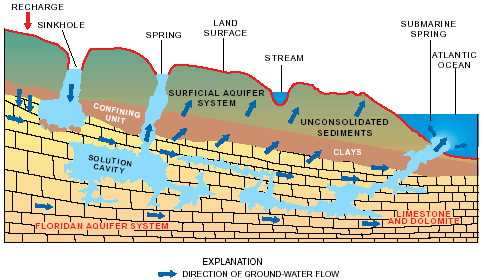Milwaukie (Indian name translation is "meeting place of waters") was founded in 1848 and incorporated in 1903. It is known as the "Dogwood city of the West" and is the birthplace of the Bing Cherry. Established by the efforts of Lot Whitcomb, who had a sawmill and gristmill, it rivaled Portland originally. But Portland became the bigger city because of the deeper port, and so Milwaukie remains the smaller of the two cities today. Milwaukie's city limits are approximately 4.8 square miles, of which only 0.04 square miles of it is water. However, water runs UNDER the city in such excess that the swimming pool that used to be near this location was kept full for many years by using the nearby spring (the City never had to "pay" for water for the City-operated pool).
Look across the street from the posted coordinates and see the underground spring spilling out into sight in the form of a small waterfall.
Water is continually moving around, through, and above the Earth (vapors, liquids and ice). The Earth is pretty much a "closed system" - meaning that the Earth neither gains or loses much matter, including water. This means that the same water that existed on the Earth millions of years ago is still here......thanks to the Water Cycle.

The same water is continually being recycled all around the globe. About 97 percent of all water is in the oceans (which is too saline to drink), which means only 3 percent of all Earth's water is usable = freshwater. To make matters worse, about 69 percent of that freshwater is locked up in glaciers and icecaps. So you might be surprised that of the remaining freshwater, almost all of it is BELOW YOUR FEET. No matter where you are standing on Earth, chances are that at some depth below you the ground is saturated with water. Indeed, rivers and lakes only supply about 0.007 percent of our total water!

The water below your feet is critically important to life, as it is an important part of the water cycle - which becomes your drinking water. "But in Oregon, we have so much rain" - you say? Indeed, we are fortunate to have an ample supply of this important resource. In fact, 1.1 percent of our state is covered in water. However, no matter how much or less you have of water, it makes no difference if you cannot collect it, use it, and dispose of what you don't want. The early settlers of Milwaukie found this out very quickly! A Pioneer family of 4 used about 100 gallons of water per day (you have to water that garden to eat and you have animals, too). At over 8 pounds per gallon, this became a pretty heavy and time-wasting daily chore! After creating a well, figuring out a pump system to collect it (water does not run up hill), collecting available ground water, storing water for future use, and then collaborating with your neighbors to successfully collect, distribute, and dispose of wastewater - you are beginning to see how complicated this whole water system is!
Your fellow Milwaukie-ans have done a lot of work in the past 100 years......you now have several components of a water system to aid you in using this valuable resource: 100 miles of water main, 964 fire hydrants, 6,911 water services, 7 well houses, 3 storage reservoirs, a wastewater treatment facility, and 4 pump stations. Part of this system, and where we get some of our well water, includes underground springs. Milwaukie has many of them due to the clay layers under our feet, but only one prominent spring that helps keep us in water supply: Minthorn Springs. It was the original source of water for the City of Milwaukie back in the days of its origin, and provided most of the inhabitants with their daily drinking water. The spring originates near Highway 224 and 37th Avenue (Minthorn Natural Area), makes its way through Mill Pond, down to this waterfall, past the Library, and into Johnson Creek. (Note: Crystal Springs, which runs through a small part of Milwaukie, originates from the area in and around the Rhododendron Gardens in SE Portland in the Eastmoreland neighborhood.)
A spring is a water resource formed when the side of a hill, a valley bottom or other excavation intersects a flowing body of ground water at or below the local water table, below which the subsurface material is saturated with water. A spring is the result of an aquifer being filled to the point that the water overflows onto the land surface. They range in size from intermittent seeps, which flow only after much rain, to huge pools flowing hundreds of millions of gallons daily. Milwaukie's varied springs are due to the fact that our clay layers in the underground soil do not provide one containing layer across town (they are in varied layers that do not provide much containment).

The amount of water that flows from springs depends on many factors, including the size of the caverns within the rocks, the water pressure in the aquifer, the size of the spring basin, and the amount of rainfall. Human activities also can influence the volume of water that discharges from a spring: groundwater withdrawals in an area can reduce the pressure in an aquifer, causing water levels in the aquifer system to drop and ultimately decreasing the flow from the spring. Most people probably think of a spring as being like a pool of water. Normally that is the case. But springs can occur when geologic, hydrologic, or human forces cut into the underground layers of soil and rock where water is in movement.
Springs are often classified by the volume of the water they discharge. The largest springs are called "first-magnitude," defined as springs that discharge water at a rate of at least 2800 liters or 100 cubic feet (2.8 m3) of water per second. The scale for spring flow is as follows:
- 1st magnitude = over 44,448 gallons per minute (over 100 cubic feet)
- 2nd magnitude = 4,448 to 44,448 gallons per minute
- 3rd magnitude = 448 to 4,448 gallons per minute
- 4th magnitude= 100 to 448 gallons per minute
- 5th magnitude = 10 to 100 gallons per minute
- 6th magnitude = 1 to 10 gallons per minute
- 7th magnitude = 1 pint to 1 gallon per minute
- 8th magnitude = Less than 1 pint per minute 0 magnitude = no flow (sites of past/historic flow)
To get credit for and log this Earthcache as found, you must email your answers to the following questions to the cache owner:
1. Estimate what level of magnitude you believe Minthorn Spring is (answer 1.a). How did you arrive at this answer (answer 1.b)? Based on your answer, how much water passed through the small waterfall visible nearby during the time you were at this spot (answer 1.c)? (This will require you to also state how many minutes you used to come up with your calculation.)
2. Think a bit about what amount of water you/your household uses per day. How does that relate to what you know about the entire Water Cycle for where you live (answer 2.a)? What is one initial thought you have about your water use (answer 2.b)? Include these answers in your email.
DO NOT include your answers in your log, or your log will be deleted.
If you like, include a picture of yourself or a member of your party with the small waterfall in the picture. Or any fun picture you have of your caching quests today or in your recent adventures. The cache owner loves pictures!
This cache location is on public property. No special permission is required.
More information can be obtained from USGS (United States Geological Survey) at www.usgs.gov
Special thanks to Don Simenson, Public Works, City of Milwaukie
Congrats to "hikerbabe n thebirdr" for the FTF on this cache!
This cache was part of the 2012 North Clackamas County Chamber of Commerce Geocoin: July 22, 2012 to October 1, 2012

Erzrzore na rnegu pnpur unf ab pbagnvare. Lbh zhfg rznvy gur bjare gur nafjre gb gur dhrfgvbaf.